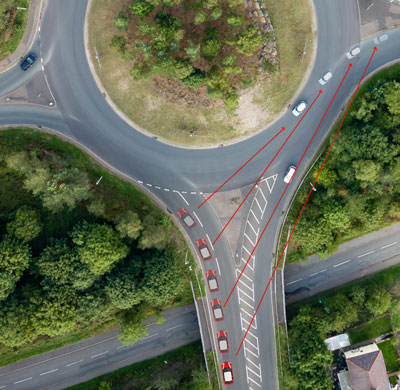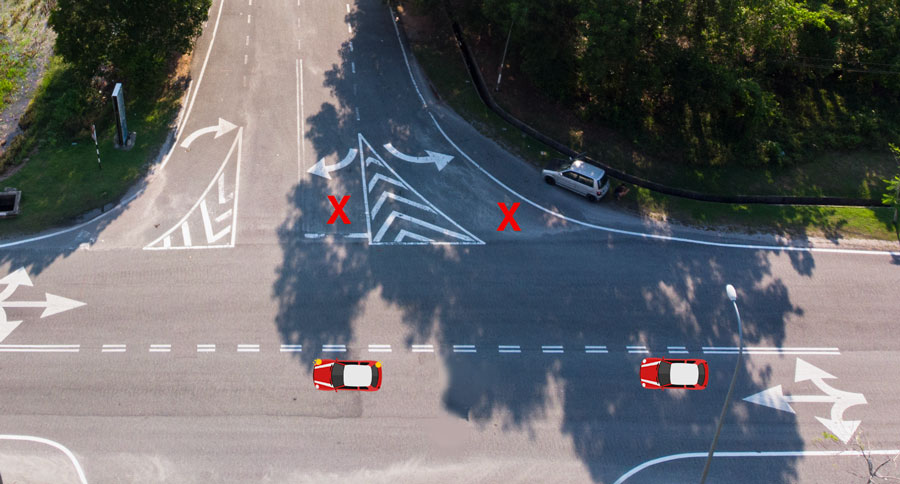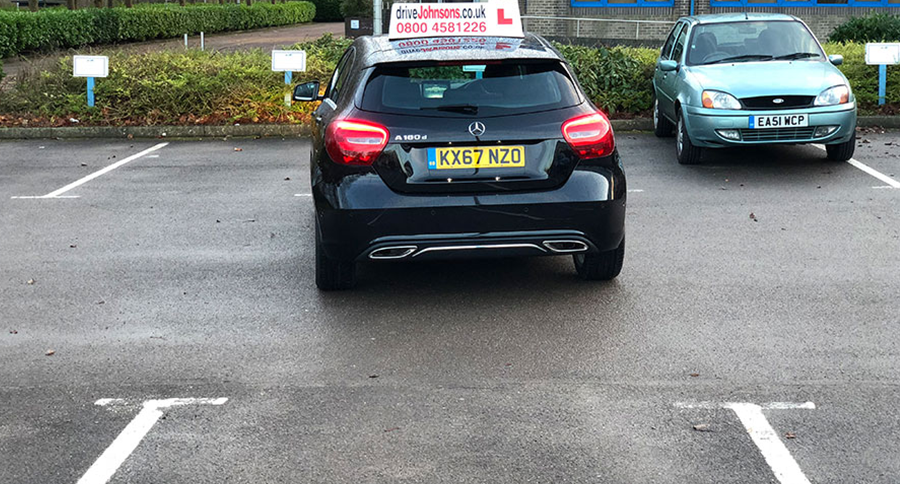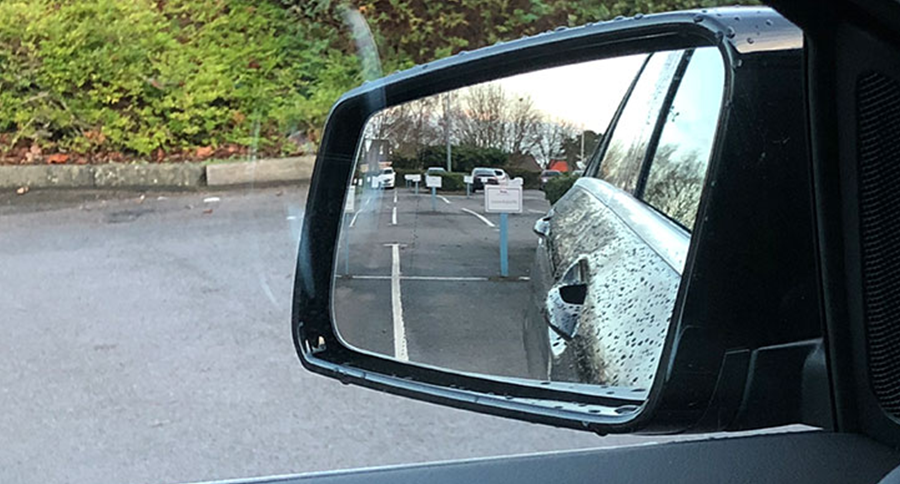It’s completely normal to feel nervous before your practical driving test, but knowing the common reasons for failing your driving test can make a huge difference to your confidence. Understanding the potential pitfalls can help you ensure you avoid them by practising and strengthening areas where you could be caught out on your test.
Top 10 reasons for failing a driving test: a deep dive
The Driver and Vehicle Standards Agency (DVSA) has published their top 10 reasons for failing the driving test. The DVSA is the governing body that marks and monitors every driving test. Unfortunately, can’t give their opinion or educate people on why and what to do next time, but that’s where our expert guidance comes in. In this article, we do a deep dive into the top 10 reasons for failing the driving test and how to overcome them.

- Reason 1: Observations at junctions
- Reason 2: Mirrors changing direction
- Reason 3: Control – steering
- Reason 4: Junctions – turning right
- Reason 5: Move off – safely
- Reason 6: Response to signs – traffic lights
- Reason 7: Move off – control
- Reason 8: Positioning – normal driving
- Reason 9: Response to signs – road markings
- Reason 10: Reverse park – control
- Frequently asked questions
Reason 1: Observations at junctions
Not performing the right observations at junctions is the most common reason for people failing their driving tests.
To avoid confusion, a junction is where traffic meets, and a vehicle has to give way to another vehicle. Common junctions are:
What is meant by observation?
If a pupil fails due to observations at a junction, this means they failed to see or react to what they saw, stop, and give way to another vehicle at the junction. Sometimes, this might mean the examiner has to dual-control the car, and sometimes the pupil stops extremely late, which may cause a rear-end accident. If the pupil stops just in time, this may be a serious fault, and if the examiner takes dual control of the car, this is often deemed a dangerous fault. Either way, a serious or dangerous fault means you have failed the driving test.
Learners taking their driving lessons in Milton Keynes often find that roundabouts are one of the biggest challenges when it comes to observations, as they are everywhere. It’s a common issue across busy towns and cities, but Milton Keynes in particular has so many roundabouts that it really puts observation skills to the test. And when it comes to test day, roundabouts are actually the number 1 junction for failing observations. The reason for this is that many are linked to high-speed 60-70mph roads, so these are always going to be more nerve-racking for an examiner if a pupil on their test isn’t slowing down for a large roundabout in good time. The consequence of a car meeting another car at 30mph while going onto a roundabout is extremely high. This can often cause an impact speed of up to 60mph, and involve other cars too.
What to do to avoid this
Firstly, listen to the examiner’s instructions and respond in good time. If the examiner says, “At the roundabout, turn right,” then it’s worth getting into that right-hand lane early on. Sometimes it’s not always easy to get into an alternative lane with other cars passing, so preparing/starting the MSPSL routine early is vital for a good approach.
Once you are in the correct lane, it’s time to start checking the junction early, but don’t forget to look ahead as well. Many learners forget to look ahead, and then they don’t see the car in front slowing down, resulting in an accident.
Think, “Check the right, look ahead. Check the right, look ahead. Check the right, look ahead.” You may have to repeat this 5-7 times, depending on how busy the roundabout is. Just before you go, don’t forget to look ahead again to make sure the car in front has moved onto the roundabout. If there are lots of cars in front of you, then focus on the cars in front and check the right more as you get closer to your turn, leaving the roundabout.

Reason 2: Mirrors changing direction
On the driving test report form below, you can see this area is highlighted red.
The examiner will mark you as having failed this if they decide that you have not checked your mirrors properly before changing direction, such as turning left or right, overtaking, or moving around parked cars. Check your interior mirror first, then the relevant door mirror, before signalling or altering your road position. If you don’t, and it affects another driver, you will receive a serious fault and fail your test.
Here are a couple of common faults and our recommendations on how to avoid them:
- Changing lanes and not checking the mirrors at all. Often, many learners check the mirrors and put on a signal, but looking at the mirror, they don’t notice a car approaching at high speed and about to pass them in the right-hand lane. They begin to change lanes, and, as a consequence, the examiner doesn’t want to die, so they will go for the steering wheel or dual control the car. In this instance, more than one mirror check is required to assess the passing vehicle’s speed. The first check may tell us the car is 100 metres away. However, if you recheck the mirror 1-2 seconds later before putting the signal on, the vehicle may be about to pass 50 metres away, which may then tell us to wait until the car passes before completing the full MSPSL routine.
- Moving out from a parked car – bike/fast car in a hurry, trying to pass. You may be the lead vehicle about to pass a parked car after giving way, but if you see a naughty person behind you about to pass you in a hurry, you should probably hold back or at least put on a signal, re-check your mirrors, and see if they have reacted to your potential move. If they decide to pass you in a hurry, despite your signal, then it’s safer to hold back.
In summary, the interior door mirror should usually be checked first before a door mirror; nevertheless, don’t be afraid to check the door mirrors more than once in busy traffic before continuing the MSPSL routine.
Reason 3: Control – steering
Many learners may think this is to do with crossing your hands when steering. Crossing your hands on the driving test can only be marked as a driving fault if you don’t have control of the car. Some experienced drivers are very good at controlling the car by crossing their hands. However, it is generally preferred not to cross your hands, especially if your driving experience is low.
Examples of failing your test for steering are the following:
- Hitting the kerb or going up the kerb.
- Sudden and unnecessary movements of the steering wheel.
- Steering too slowly around a parked car.
- Leaving your hand on the gear lever for too long. Experienced drivers often do this.
What to do to avoid this
To demonstrate that you are in control, always aim for smooth, steady steering, rather than sudden or jerky movements. Nerves can make your movements more sharp, and breathing slowly can help calm and reduce these. Keep both hands on the wheel as much as you can, and always plan your steering early, looking ahead to judge how much you will need to turn the wheel.
Reason 4: Junctions – turning right
This is a subject that is covered quite early on for learners. However, the difficulty level really can vary from turning right into a quiet country road to turning right with a box junction during an 8:10am test in a busy area of London, such as Harrow. The faults that usually occur here include adopting an incorrect position for turning right, stopping too early, or stopping too late, making it extremely difficult to turn into the junction.
Some learners do what’s called a corner cut, which means they turn too early, risking a collision with cars coming out of the junction. Lastly, crossing traffic and misjudging the oncoming car is extremely dangerous.
What to do to avoid this
A simple rule to remember, which will work for 30mph roads or less, is that if you can walk across the road before the oncoming car arrives, then you can drive across the road in time. This is based on the oncoming car doing 30mph or less. If they are a mad driver doing 60mph, you should be able to gauge this if you are approaching test standard, and you may decide to hold back.

Reason 5: Move off – safely
Sounds easy, right? Maybe if you’re taking driving lessons Ipswich and are moving off in a quiet rural area outside of town. However, even if you do live in a rural area and it’s quiet, often the examiner will ask you to pull up on either side of the road in a busy area to test how you deal with other cars from a parked position.
Here are some examples of “move off – safely” fails:
- Pulling out in front of another car, forcing oncoming traffic to slow down or overtake/change lanes.
- Putting a signal on as a car is about to pass, causing that car to change direction, swerve, or sound the horn out of panic.
- Moving away without observations (360/6 point check), moving out at the same time as a pedestrian walks into the road behind.
The most serious faults for moving off safely tend to be due to poor judgment or lack of observations.
What to do to avoid this
Observe carefully before moving off, ensuring that it is safe to pull out before you do. Signal clearly, and hold back from pulling out until other road users have passed if you think you might force them to slow down. Move off smoothly and confidently as soon as you can.
Reason 6: Response to signs – traffic lights
There are many different ways of getting this wrong. Here are some of the most common:
- Failing to stop in time for a red light or not stopping at all.
- Slowing down too much for a green light (some learners overanalyse things during their tests).
- Not understanding the different amber sequences for different light types:
- Amber: Stop if you can do so safely
- Red and amber together: Get ready to go
- Flashing amber: Proceed if it’s clear and safe
- Not understanding the rules for traffic lights with green filter arrows. Some people see red and stop when they can actually continue if the green arrow is showing to turn left, right, or go straight on. See the image above.
What to do to avoid this
Firstly, understand the different sequences available on pedestrian crossings and traffic lights. If you thoroughly understand all of the amber sequences, that should avoid any confusion at traffic lights or crossings on the day of your driving test.
Secondly, when you have seen a green light for a long time, you should check your mirrors and come off the gas on the approach. It’s unlikely you will need to brake as well. If the light remains green 2-3 car lengths away, then you have usually passed the point of stopping safely. At this point, go back on the gas and clear the traffic light.
Reason 7: Move off – control
The most common fault here is stalling. Most people are nervous on their driving tests; if you’re a nervous person, you may benefit from having a mock test with your driving instructor.
Some other reasons for failing the “control” section while moving off are:
- Rolling backwards when trying to move forward – this is most common on hill starts.
- Moving away in the wrong gear – many learners stop at a junction in 2nd or 3rd gear, then try to move away again forgetting to drop the gear down into 1st before moving away.
- Juddering when moving off – this means the car was close to stalling. The most common cause is not setting enough gas when trying to move away quickly, for example, at roundabouts.
What to do to avoid this
So many people stall the car because, during the test, their clutch control suffers. The left foot and even the leg can judder a bit more as a result of the nerves. This makes it much harder to have good clutch control.
TIP: Try to keep your heel on the floor when holding the clutch at the biting point. If your heel is off the floor when you are coordinating the clutch, you may struggle with good clutch control when you’re nervous.
One famous person who had their driving lessons in Leicester was Stephen Graham, famous for appearing in Pirates of the Caribbean and the BBC’s Line of Duty, was nervous. He was nervous and stalled the car. However, he still passed first time with driveJohnson’s.
Stephen said, “When I stalled, I just remember what my instructor said to me – don’t panic, secure the car and make sure it doesn’t roll forwards or backwards. Check it’s in the correct gear, clutch down and restart the car. Keep repeating those words on the lead up to your test and hopefully it will help you, like it did me.”
Reason 8: Positioning – normal driving
Is this about driving along in a straight line? Not quite – there’s more to it than that. During your test, your examiner will be keeping an eye out to see if you are keeping your car in a safe and suitable place on the road. You will need to show that you can do this consistently when you drive, not just when you are on a straight road.
Things to watch out for to avoid this fault
- In high winds or on faster roads, you may drift slightly left or right. Try to stay in your lane at all times. Some instructors might provide you with a focal/reference point for you to use to keep a good position in a straight line. On wide roads, we usually suggest staying approximately 1 metre away from the kerb.
- Avoid moving in and out of parked cars unless it’s necessary. For example, if you feel like you are doing a slalom between cars and nobody is approaching or behind you, you may be marked down for this.
- Check your lane position when approaching and at junctions (especially roundabouts).
- Using the right-hand lane for longer than necessary after an overtake. Once you have overtaken the vehicle(s), check if it’s safe to come back into the left-hand lane. If you stay in the right-hand lane for longer than necessary, other road users can get angry, impatient, and may drive recklessly by tailgating you or undertaking.
Reason 9: Response to signs – road markings
You must show the examiner that you understand road signs and not disobey them. This may seem obvious, but with test nerves, thinking properly can go out of the window, and suddenly you find yourself making mistakes.
Some common reasons for failing regarding road signs and markings are:
- Failing to stop at a stop sign
- Overtaking when there is a “no overtaking” sign present
- Not giving way to oncoming cars
- Stopping in no-stopping areas where signs are visible
- Driving in bus lanes during bus operating hours
- Avoiding a bus lane while not in it’s operating hours
- Going down a no-entry road, which is clearly marked with a no-entry sign
- Taking up an incorrect position for turning right down a street that is clearly signposted as a one-way street
What to do to avoid this
Unfortunately, there is no quick tip here. The best and surest advice is to read up on and familiarise yourself with the highway code for traffic and road signs.
Make sure you understand them all. If you don’t understand a few of them, read up some more or ask your driving instructor to explain them to you.
Reason 10: Reverse park – control
This refers to the parallel park exercise or the reversing into a parking bay exercise.
Common reasons for failing are:
- Poor clutch control.
- Stalling too many times – often the learner has their foot on the brake while trying to move backwards, or they are braking with the clutch at its biting point throughout the manoeuvre.
- Finishing position is incorrect – not within the white lines on the bay park, and for parallel parking, too far away from the kerb, on the kerb, or too far away from the car in front. You should aim to finish a maximum of two car lengths away from the car in front.
- Going over the white lines too much during the bay park manoeuvre.
TIP: With both manoeuvres, the door mirrors can be your best friend, but if you get too matey with them (stare into them for too long), then you can also fail for observations for not being observant and aware of other road users or hazards around you. Glance in your door mirrors, but don’t stare into them. You can look in the door mirrors as regularly as you want, providing you keep looking all around you for hazards too!
There are many techniques for both manoeuvres, so it’s worth checking out our manoeuvres page for more information.
Frequently asked questions
We receive many other questions from learner drivers about failing practical driving tests. We have included a list of the ones we most often receive below.
How many minors to fail a driving test?
Receive more than 15 minor faults on your driving test and you will fail. If you receive fewer than 16 minor faults without any serious or dangerous faults, you will still pass.
How many serious faults to fail a driving test?
Just one serious fault will result in a failed driving test. You can find out more about how many mistakes you make on your driving test here.
How many times can you fail a driving test?
Thankfully, there is no limit to the number of times you can take your practical driving test.
Can you appeal a driving test fail?
Yes, you have the right to appeal the result of your driving test if you fail, but only if you believe that your examiner did not follow the correct legal procedure on your test. You can check if you have grounds to appeal here.
Can you rebook a driving test after failing?
If you do fail your driving test, you just need to wait 10 days, and then you can book another test on the DVSA website here.
Final thoughts on how to gain test success
Taking your driving test is extremely nerve-racking for many learners. Not many people in life enjoy being tested, but one thing you can do is practise dealing with pressure.
At driveJohnson’s, we will often perform mock driving tests with our pupils and, in some instances (if required), we will link up with another instructor so they can perform a mock test with the learner too. A new face performing a mock test is just one of many ways of practising coping under pressure! Another way is to check where the hardest and easiest driving test centres are near you.
Failing the driving test can be devastating for many, and it can really knock your confidence. If you are thinking of booking your test, try not to add extra pressure on yourself to pass, like applying for jobs that require a driving licence or telling all your mates your test is coming up. Less pressure means lower nerves and anxiety.
Good luck with your driving test!

Written by Anthony Johnson
Grade A - 51/51
ORDIT Registered Trainer












